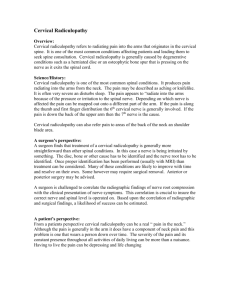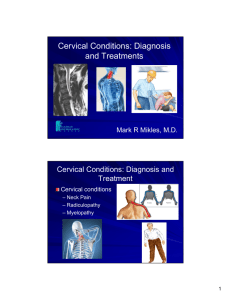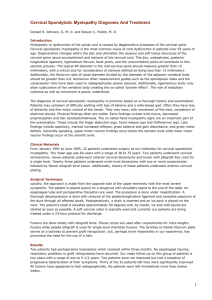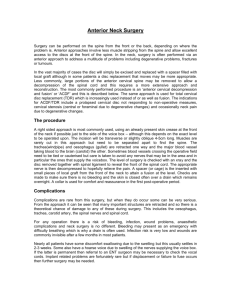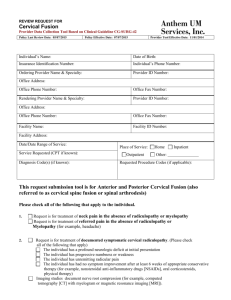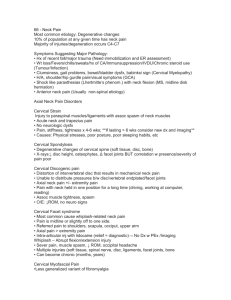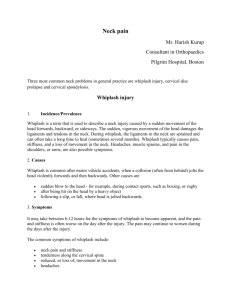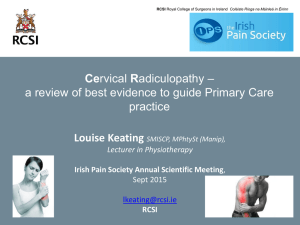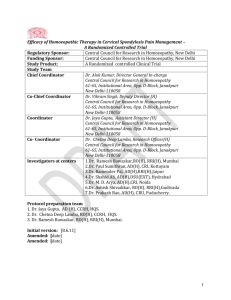Cervical Syondylosis
advertisement
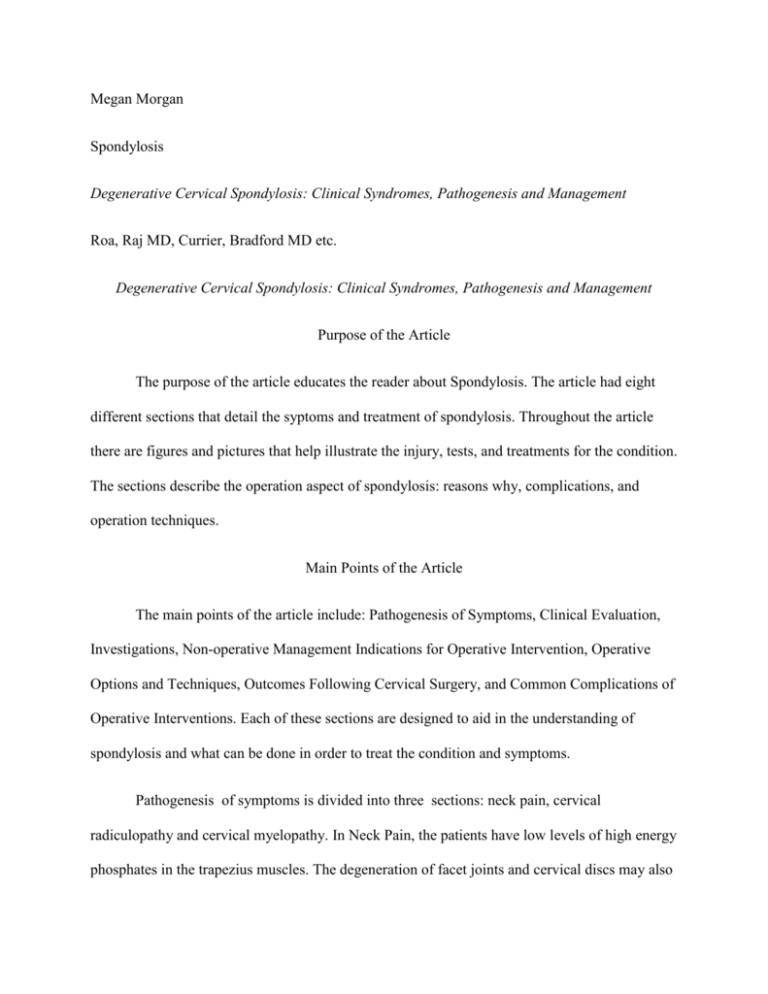
Megan Morgan Spondylosis Degenerative Cervical Spondylosis: Clinical Syndromes, Pathogenesis and Management Roa, Raj MD, Currier, Bradford MD etc. Degenerative Cervical Spondylosis: Clinical Syndromes, Pathogenesis and Management Purpose of the Article The purpose of the article educates the reader about Spondylosis. The article had eight different sections that detail the syptoms and treatment of spondylosis. Throughout the article there are figures and pictures that help illustrate the injury, tests, and treatments for the condition. The sections describe the operation aspect of spondylosis: reasons why, complications, and operation techniques. Main Points of the Article The main points of the article include: Pathogenesis of Symptoms, Clinical Evaluation, Investigations, Non-operative Management Indications for Operative Intervention, Operative Options and Techniques, Outcomes Following Cervical Surgery, and Common Complications of Operative Interventions. Each of these sections are designed to aid in the understanding of spondylosis and what can be done in order to treat the condition and symptoms. Pathogenesis of symptoms is divided into three sections: neck pain, cervical radiculopathy and cervical myelopathy. In Neck Pain, the patients have low levels of high energy phosphates in the trapezius muscles. The degeneration of facet joints and cervical discs may also be the reason for the neck pain. In Cervical Radiculopathy, it gives a possible reason for why a compressed nerve causes pain. Reasons for degeneration of discs include biomechanical and biochemical changes due to age and also herniated discs. In Cervical Myelopathy, the stated mechanism is compression of the spinal cord. Patients that have myelopathy may also have other spinal deformities causing the compression of the spinal cord. Clinical Evaluation is also divided into Neck Pain, Cervical Radiculopathy and Cervical Myelopathy. In Neck Pain, it overs the possible diagnosis of different neck pain based on where the pain is felt and if range of motion is affected. In Cervical Radiculopathy, the percentages of different areas with pain, motor, reflex and sensory deficits and headaches are discussed in patients with cervical radiculopathy. Also included in this section is a chart representing the percentages. Cervical Myelopathy, discusses symptoms of the condition including: uncoordination with hands, walking, abnormal reflexes, and other complications with both upper and lower extremities. Investigations discuss the different techniques used to diagnose spondylosis. Plain radiographs, computed tomography with myeliography, magnetic resonance imaging, and electrodiagnotic studies are the main techniques used for diagnosis. Electrodiagnositic studies help differentiate the symptoms of spondylosis. MRIs are used to assess the soft tissue of the spine and locate possible deformities. Computed tomography with myelopathy are used to find bone spurs and other issues with the bone structures. Plain radiographs are used to find deformities with the discs and spine. Non-operative Management covers possible ways to deal with spondylosis without having surgery to correct it. There are medications available to help with neck pain and radiculopathy. Physical therapy may increase ROM and stretching the muscles. Injections of corticosteroids may be offered to help relieve the pain. Indications for Operative Intervention discusses the indications for surgery to help correct or stop the symptoms of spondylosis. If the patient is placed on a non-operative treatment and does not respond to it within a year and the pain is high, then surgery may be considered. If nerve root impingement becomes apparent and they do not respond to treatment within six to twelve weeks then surgery is apparent. Surgery is also considered for patients with radiculopathy that do not respond to treatment within three months. There are many different operative options and techniques used to help with spondylosis. Anterior cervical discectomy and corpectomy, anterior fusion, anterior cervical plates and posterior cervical instrumentation are choices and techniques in order to relieve the symptoms and effects of spondylosis. Outcome following cervical surgery is divided into three sections: neck pain, cervical radiculopathy and cervical myelopathy. Neck pain can be managed and treated with no operation. For cervical radiculopathy patents, the anterior cervical discectomy and fusion are the best operational techniques. Either anterior discectomy or corpectomy without having instrumentation done help decrease the pressure on the spinal cord thus reducing the symptoms of cervical myelopathy. Common Complications of Operative Intervention include: neck pain, neck stiffness, instability and kyphosis, dysphagia, adjacent-segmented deterioration and complications with instrumentation. Although these are serious side effects to the operation only a small percentage of the patients suffer from them.
